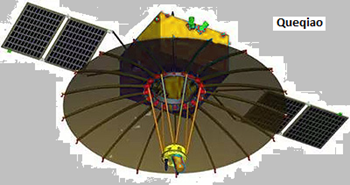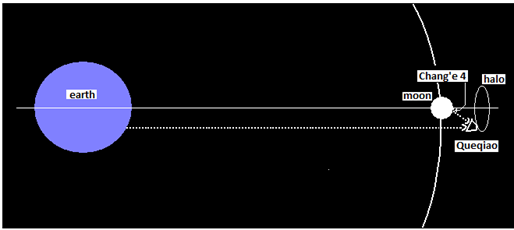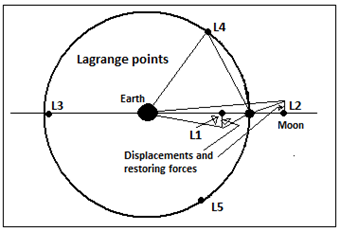The unseen part of the moon is not in radio contact, says S.Ananthanarayanan.
From the earth, we can see only one face of the moon. This is because the moon, unlike the earth, turns around on its axis only once every 28 days, the same time as it takes to go around the earth. The result is that although all parts of the moon get to point towards the sun over the ‘lunar day’, the face that is pointed towards the earth is always the same.
The face of the moon that we see has hence been extensively studied by telescope. And several probes, including manned missions, have landed on this face of the moon. A reason for landing on this face is that we can make good use of a probe or a manned mission to the parts that we are able to see. Another reason is that radio communication with the moon needs to be through ‘line of sight’. As this is not possible on the far side of the moon, missions to that side were not attempted.
There is interest, of course, in the far side of the moon, which has been mapped, so far, with the help of satellites that were placed in orbit around the moon. And a special interest has been that a mission to the far side could remedy a current deficiency. The deficiency is that we have studied only the surface of the moon, and hardly have an idea about its internals. As bore holes are typically good for a few meters, we could do better if we start the bore hole at the bottom of a natural depression, say one caused by an asteroid strike – and this is where the far side of the moon can help - the deepest depression on the surface of the moon is located on the far side.
The Chinese Lunar Exploration Programme took the first step by landing Chang’e 4, a robotic spacecraft, on the far side of the moon in January 2019. The lander carried Yutu-2, a robotic, lunar rover, which could identify the mineral content of the bottom of the crater, to look for traces of what there may lie deeper.
But how could the landing of Chang’e 4 be managed, and Yutu-2 controlled, and data taken back to the earth, without a radio link? Lihua Zhang, from the DFH Satellite Company Ltd, in Beijing, describes in the AAAS journal, Space: Science and Technology, the arrangement for ‘relay communication’ that was put in place before Chang’e 4 was launched. The company, DFHSat, is a professional company, a part of the policy of including private participation in aerospace innovation. The company, which is under the Chinese Academy of Space Research, provides space communications services worldwide and has arranged the launch of scores of satellites.

The solution provided to Chang’e 4 was to place Queqiao, a radio repeater satellite, in the proximity of the moon, so that it was constantly in ‘line of sight’ both with the earth and the far side of the moon, as shown in the picture. And how did the device stay in this position, with respect to the moon, while the moon moved in its orbit around the earth? Well, this was because of the interplay of combined gravitational forces of the earth and the moon, which provided for special places where the satellite was stationary, with respect to the earth-moon positioning.

In effect, the device is also in orbit around the earth. But as it is further away from the earth than the moon, it should follow a slower orbit and fall behind. This is corrected, however, by the gravitational pull of the moon, which speeds up the orbit to be as fast as the moon’s own orbit. And the device is in orbit around the moon too, but moving around the moon at the same speed as the moon’s rotation, so that it always faces that same side of the moon’s surface. And to maintain its position, it is helped by the gravitation of the earth, in addition to that of the moon.
In cases of pairs of objects, like the earth and the moon, there are a handful of special points where the gravity of one object just compensates the gravity of the other object. One such point, shown as L1 in the diagram, would lie directly between the two objects, and we can see that it would be nearer the smaller of the two objects. Another point, shown as L2, would be beyond the smaller object. At L2, the tendency of the device to fly away from the earth, as the earth’s pull is weaker, is compensated by the pull of the moon, which adds to the earth’s pull. L3 is the third point, which is on the opposite side of the earth. And then there are L4 and L5, which are on either side, kept at their distance from the earth or the moon because of their relative motion.

The relative motion of a pair of objects, one object in orbit around the other, is the classical problem of the earth and the moon, which was solved by Isaac Newton. If we introduce a third object, with all three objects interacting, however, the problem becomes impossible to solve. Except that if the third object is so small that its effect on the other two can be ignored, then, a solution is possible. This is what is done when considering the radio repeater device, which is miniscule compared to the moon or the earth. This case had first been worked out by the mathematician Joseph-Louis Lagrange, and the five points where the third object can be relatively stationary are known as Lagrange points
The points L4 and L5, are stable, but the others are partially stable, which is to say they move, and stray from the Lagrange point. The DFHSat team placed Queqiao at the point L2, which is a partially stable point. The satellite hence moves in an unstable orbit, over an area called a halo. And hence needs to periodically correct its position. The movement away from L2, however, makes it possible for Queqiao to be in ‘line of sight’ of the earth as well as the surface of the far side of the moon for most of the time.
The paper by the DFHSat scientist explains that Queqiao uses a pair of antennae and separate channels of communication – one for control of the lander and rover on the surface of the moon and another for transmission of the data collected. Thanks to Queqiao, a great deal of data has been collected over the two years that Chang’e 4 has been in position. There are plans for more exploration and a role for radio links like this, particularly in a plan to study the terrain at the south pole of the moon.
------------------------------------------------------------------------------------------ Do respond to : response@simplescience.in-------------------------------------------